Rajneeshpuram
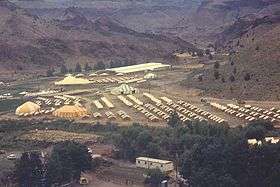
Rajneeshpuram was an intentional community in Wasco County, Oregon, briefly incorporated as a city in the 1980s, which was populated with Rajneeshees, followers of the spiritual teacher Bhagwan Shree Rajneesh,[1][2] later known as Osho.[3]
Settlement
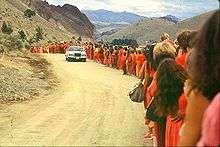
The city was on the site of a 64,229-acre (25,993 ha) Central Oregon property known as the Big Muddy Ranch, near Antelope, Oregon,[4] which was purchased in 1981 for $5.75 million ($15.5 million in today's dollars[5]). Within three years, the neo-sannyasins (Rajneesh's followers, also termed Rajneeshees in contemporaneous press reports) developed a community,[6] turning the ranch from an empty rural property into a city of up to 7,000 people, complete with typical urban infrastructure such as a fire department, police, restaurants, malls, townhouses, a 4,200-foot (1,300 m) airstrip, a public transport system using buses, a sewage reclamation plant and a reservoir.[7] The Rajneeshpuram post office had the ZIP code 97741.[8]
Within a year of arriving, the commune leaders had become embroiled in a series of legal battles with their neighbours, the principal conflict relating to land use.[7] Initially, they had stated that they were planning to create a small agricultural community, their land being zoned for agricultural use.[7] But it soon became apparent that they wanted to establish the kind of infrastructure and services normally associated with a town.[7] The land-use conflict escalated to bitter hostility between the commune and local residents, and the commune was subject to sustained and coordinated pressures from various coalitions of Oregon residents over the following years.[7][9]
Increasing tensions
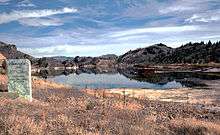
The city of Antelope, Oregon, became a focal point of the conflict.[7] It was the nearest town to the ranch, and had a population of under 60.[7] Initially, Rajneesh's followers had purchased only a small number of lots in Antelope.[7] After a dispute with the 1000 Friends of Oregon, an environmentalist group, Antelope denied the sannyasins a business permit for their mail-order operation, and more sannyasins moved into the town.[7] In April 1982, Antelope held a vote to disincorporate itself, to prevent itself being taken over.[7] By this time, there were enough Rajneeshee residents to defeat the measure.[7] In May 1982, the residents of the Rancho Rajneesh commune voted to incorporate the separate city of Rajneeshpuram on the ranch.[7] Apart from the control of Antelope and the land-use question, there were other disputes.[7] The commune leadership took an aggressive stance on many issues and initiated litigation against various groups and individuals.[7]
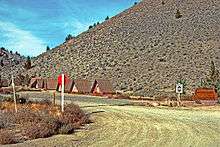
The June 1983 bombing of Hotel Rajneesh, a Rajneeshee-owned hotel in Portland, by the Islamist militant group Jamaat ul-Fuqra further heightened tensions.[7][10] The display of semi-automatic weapons acquired by the Rajneeshpuram Peace Force created an image of imminent violence.[7] There were rumors of the National Guard being called in to arrest Rajneesh.[7] At the same time, the commune was embroiled in a range of legal disputes.[7] Oregon Attorney General David B. Frohnmayer maintained that the city was essentially an arm of a religious organization, and that its incorporation thus violated the principle of separation of church and state. 1000 Friends of Oregon claimed that the city violated state land-use laws. In 1983, a lawsuit was filed by the State of Oregon to invalidate the city's incorporation, and many attempts to expand the city further were legally blocked, prompting followers to attempt to build in nearby Antelope, which was briefly named Rajneesh, when sufficient numbers of Rajneeshees registered to vote there and won a referendum on the subject.
The Rajneeshpuram residents believed that the wider Oregonian community was both bigoted and suffered from religious intolerance.[11] According to Latkin (1992) Rajneesh's followers had made peaceful overtures to the local community when they first arrived in Oregon.[7] As Rajneeshpuram grew in size heightened tension led certain fundamentalist Christian church leaders to denounce Rajneesh, the commune, and his followers.[7] Petitions were circulated aimed at ridding the state of the perceived menace.[7] Letters to state newspapers reviled the Rajneeshees, one of them likening Rajneeshpuram to another Sodom and Gomorrah, another referring to them as a "cancer in our midst."[7] In time, circulars mixing "hunting humor" with dehumanizing characterizations of Rajneeshees began to appear at gun clubs, turkey shoots and other gatherings; one of these, circulated widely over the Northwest, declared "an open season on the central eastern Rajneesh, known locally as the Red Rats or Red Vermin."[12]
As Rajneesh himself did not speak in public during this period, and until October 1984 gave few interviews, his secretary and chief spokesperson Ma Anand Sheela (Sheela Silverman) became, for practical purposes, the leader of the commune.[7] She did little to defuse the conflict, employing a crude, caustic and defensive speaking style that exacerbated hostilities and attracted media attention.[7] On September 14, 1985, Sheela and 15 to 20 other top officials abruptly left Rajneeshpuram.[7] The following week, Rajneesh convened press conferences and publicly accused Sheela and her team of having committed crimes within and outside the commune.[7][13] The subsequent criminal investigation, the largest in Oregon history, confirmed that a secretive group had, unbeknownst to both government officials and nearly all Rajneeshpuram residents, engaged in a variety of criminal activities, including the attempted murder of Rajneesh's physician, wiretapping and bugging within the commune and within Rajneesh's home, poisonings of two public officials, and arson.[7][14]
Outcome
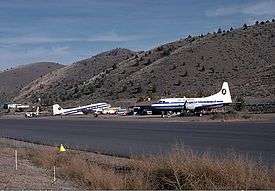

Sheela was extradited from West Germany and imprisoned for attempted murder, assault, wiretapping, and arson, immigration fraud,[15][16][17][2] and her role in infecting the salad bars of several restaurants in The Dalles (the county seat of Wasco County) with salmonella, infecting 751 people (including several Wasco County public officials), and resulting in the hospitalization of 45 people.[18][19] Known as the 1984 Rajneeshee bioterror attack, the incident is regarded as the largest biological warfare attack in the history of the United States. These criminal activities had, according to the Office of the Attorney General, begun in the spring of 1984, three years after the establishment of the commune.[7] Rajneesh himself was accused of immigration violations, to which he entered an Alford plea. As part of his plea bargain, he agreed to leave the United States and eventually returned to Poona, India. His followers left Oregon shortly afterwards.
The legal standing of Rajneeshpuram remained ambiguous. In the church/state suit, Federal Judge Helen J. Frye ruled against Rajneeshpuram in late 1985, a decision that was not contested, since it came too late to be of practical significance.[20] The Oregon courts, however, eventually found in favor of the city, with the Court of Appeals determining in 1986 that incorporation had not violated the state planning system's agricultural land goals.[20] The Oregon Supreme Court ended litigation in 1987, leaving Rajneeshpuram empty and bankrupt, but legal within Oregon law.[20][21]
Washington Family Ranch
Dennis R. Washington's firm Washington Construction purchased The Big Muddy Ranch from the state in 1991. Washington attempted to run the ranch for profit, and also unsuccessfully negotiated with the state to turn it into a state park.[22]
In 1996, Washington donated the ranch to Young Life, a Christian youth organization. Since 1999, Young Life has operated a summer camp there, first as the WildHorse Canyon Camp, later as the Washington Family Ranch.[22][23]
The Big Muddy Ranch Airport is also located there.[24]
See also
| Wikimedia Commons has media related to Rajneeshpuram. |
- 1985 Rajneeshee assassination plot
- Wild Wild Country, a 2018 documentary on the Rajneesh disputes
- Ecclesia Athletic Association another contemporaneous Oregon organization which drew comparisons to Rajneeshpuram
Notes
- ↑ "Incorporation of Rajneeshpuram opens door to development (part 9 of 20)". The Oregonian. July 8, 1985. Retrieved June 1, 2018.
- 1 2 "Bhagwan Shree Rajneesh FBI File". Retrieved June 1, 2018.
- ↑ "Bhagwan Shree Rajneesh Biography". Retrieved June 1, 2018.
- ↑ Win McCormack (2010). The Rajneesh Chronicles: The True Story of the Cult that Unleashed the First Act of Bioterrorism on U.S. Soil. p. 144. ISBN 098256919X.
- ↑ Federal Reserve Bank of Minneapolis Community Development Project. "Consumer Price Index (estimate) 1800–". Federal Reserve Bank of Minneapolis. Retrieved January 2, 2018.
- ↑ Richardson 2004, pp. 481–486
- 1 2 3 4 5 6 7 8 9 10 11 12 13 14 15 16 17 18 19 20 21 22 23 24 25 26 27 28 Latkin 1992, reprinted Aveling 1999, pp. 339–342
- ↑ La rivoluzione interiore, Osho, Edizioni Mediterranee, 1983, page 219
- ↑ Carter 1987, reprinted in Aveling 1999, pp. 182, 189
- ↑ Carter 1990, p. 187
- ↑ Dohnal 2003, p. 150
- ↑ Carter 1990, p. 203
- ↑ Carter 1990, p. 230
- ↑ Carter 1990, p. 237
- ↑ "U.S. pursues extradition of Ma Anand Sheela". United Press International. December 5, 1985. Retrieved May 17, 2018.
- ↑ "Guru's ex-secretary to be extradited to U.S." United Press International. February 1, 1986. Retrieved May 17, 2018.
- ↑ "Ex-Aide to Indian Guru Pleads Guilty to Charges". Los Angeles Times. July 23, 1986. Retrieved May 17, 2018.
- ↑ Dylan Thuras (January 9, 2014). "The Secret's in the Sauce: Bioterror at the Salsa Bar". Slate Magazine. Retrieved May 17, 2018.
- ↑ Kashmira Gander (April 11, 2018). "Wild Wild Country: 'Sex Cult' Member Reveals Truth About Orgies, Sterilizations And Punishments att Oregon Ranch". Newsweek. Retrieved June 1, 2018.
- 1 2 3 Abbott 1990
- ↑ 1000 Friends of Oregon v. Wasco County Court, 703 P.2d 207 (Or 1985), 723 P.2d 1039 (Or App. 1986), 752 P.2d 39 (Or 1987)
- 1 2 "City of Antelope and Muddy Ranch". oregonencyclopedia.org. Retrieved 2017-04-18.
- ↑ Aney, Kathy (18 July 2015). "Once a cult compound, now world's biggest Young Life camp". East Oregonian. Retrieved 18 April 2017.
- ↑ "Rajneesh — The Ranch Today". The Oregonian. Oregon Live. April 1, 2011. Archived from the original on April 19, 2011. Retrieved July 9, 2011.
References
- Abbott, Carl (February 1990), "Utopia and Bureaucracy: The Fall of Rajneeshpuram, Oregon", Pacific Historical Review, University of California Press, 59 (1): 77–103, JSTOR 3640096
- Aveling, Harry (ed.) (1999), Osho Rajneesh and His Disciples: Some Western Perceptions, Delhi: Motilal Banarsidass, ISBN 81-208-1599-8 ludes studies by Susan J. Palmer, Lewis F. Carter, Roy Wallis, Carl Latkin, Ronald O. Clarke and others previously published in various academic journals.)
- Braun, Kirk (1984), Rajneeshpuram: The Unwelcome Society, West Linn, OR: Scout Creek Press, ISBN 0-930219-00-7 .
- Brecher, Max (1993), A Passage to America, Bombay, India: Book Quest Publishers, ISBN 978-0-943112-22-0 .
- Carrette, Jeremy; King, Richard (2004), Selling Spirituality: The Silent Takeover of Religion, New York: Routledge, ISBN 0-415-30209-9 .
- Carter, Lewis F. (1987), "The "New Renunciates" of Bhagwan Shree Rajneesh: Observations and Identification of Problems of Interpreting New Religious Movements", Journal for the Scientific Study of Religion, Blackwell Publishing, 26 (2): Pages 148–172, doi:10.2307/1385791, JSTOR 1385791 , reprinted in Aveling 1999, pp. 175–218.
- Carter, Lewis F. (1990), Charisma and Control in Rajneeshpuram: A Community without Shared Values, Cambridge: Cambridge University Press, ISBN 0-521-38554-7 .
- Carus, W. Seth (2002), Bioterrorism and Biocrimes (PDF), The Minerva Group, Inc., ISBN 1-4101-0023-5, retrieved July 12, 2011 .
- Dohnal, Cheri (2003), Columbia River Gorge: National Treasure on the Old Oregon Trail (The Making of America series), Arcadia Publishing, ISBN 978-0-7385-2432-0, retrieved September 23, 2011 .
- FitzGerald, Frances (September 29, 1986b), "Rajneeshpuram", The New Yorker .
- FitzGerald, Frances (1987), Cities on a Hill: A Journey Through Contemporary American Cultures, New York, NY: Simon & Schuster, ISBN 0-671-55209-0 . (Includes a 135-page section on Rajneeshpuram previously published in two parts in The New Yorker magazine, Sept. 22 and Sept. 29, 1986 editions.)
- Fox, Judith M. (2002), Osho Rajneesh – Studies in Contemporary Religion Series, No. 4, Salt Lake City: Signature Books, ISBN 1-56085-156-2 .
- Gordon, James S. (1987), The Golden Guru, Lexington, MA: The Stephen Greene Press, ISBN 0-8289-0630-0 .
- Latkin, Carl A. (1992), "Seeing Red: A Social-Psychological Analysis", Sociological Analysis, Oxford University Press, 53 (3): Pages 257–271, doi:10.2307/3711703, JSTOR 3711703 , reprinted in Aveling 1999, pp. 337–361.
- Latkin, Carl A.; Sundberg, Norman D.; Littman, Richard A.; Katsikis, Melissa G.; Hagan, Richard A. (1994), "Feelings after the fall: former Rajneeshpuram Commune members' perceptions of and affiliation with the Rajneeshee movement", Sociology of Religion, Oxford University Press, 55 (1): Pages 65–74, doi:10.2307/3712176, JSTOR 3712176 .
- Lewis, James R.; Petersen, Jesper Aagaard (eds.) (2005), Controversial New Religions, New York: Oxford University Press, ISBN 0-19-515682-X .
- McCormack, Win (1985), Oregon Magazine: The Rajneesh Files 1981–86, Portland, OR: New Oregon Publishers, Inc. . ASIN B000DZUH6E
- Palmer, Susan J.; Sharma, Arvind (eds.) (1993), The Rajneesh Papers: Studies in a New Religious Movement, Delhi: Motilal Banarsidass, ISBN 81-208-1080-5 .
- Quick, Donna (1995), A Place Called Antelope: The Rajneesh Story, Ryderwood, WA: August Press, ISBN 0-9643118-0-1 .
- Richardson, James T. (2004), Regulating Religion: Case Studies from Around the Globe, New York, NY: Luwer Academic/Plenum Publishers, ISBN 0-306-47887-0 .
- Shay, Theodore L. (1985), Rajneeshpuram and the Abuse of Power, West Linn, OR: Scout Creek Press . ASIN B0006YPC9O
External links
- "Untold history of the Rajneeshees in Oregon". OregonLive.com. 2018-04-19. Retrieved 2018-04-25.
- "Rajneeshpuram · Pacific University Archives Exhibits". Pacific University Archives Exhibits. Retrieved 2018-04-25.
- Davisson, Sven (2003). "The Rise & Fall of Rajneeshpuram". Ashé Journal. 2 (2). ISSN 1558-4704. OCLC 61751733. Retrieved 2018-04-25.
- "Religious Movements Homepage: Osho (or Rajneeshism)". religiousmovements.lib.virginia.edu. Archived from the original on 2006-08-28.
- Cramer, John (2001-10-14). "Oregon suffered largest bioterrorist attack in U.S. history, 20 years ago". The Bulletin. Retrieved 2018-04-25.
- "Rajneeshpuram". OPB. 2018-02-26. 2012 documentary produced by Oregon Public Broadcasting
- "Wild Wild Country". Netflix Official Site. 2018-02-28. . A 2018 Netflix documentary series on Rajneesh, focusing on Rajneeshpuram and the controversies surrounding it.[1]
- Hilow, Michael Regis; Ferris, Tom; Delisi, Bill; Wiley, Ken; Sweet Regis Productions (2008) [1995], Rajneeshpuram : an experiment to provoke God, New York, NY: Filmakers Library, OCLC 320369033
Coordinates: 44°49′54″N 120°29′06″W / 44.831667°N 120.484928°W
- ↑ Wollaston, Simon. "Wild Wild Country review – Netflix's take on the cult that threatened American life". The Guardian Newspaper.